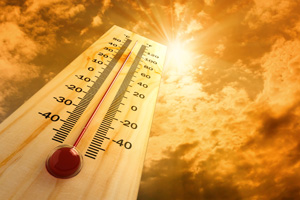Beat the Heat
It’s summer. People expect it to be hot. But this year has been particularly unbearable as cities across the country are experiencing record-setting high temperatures. Heat exhaustion, dehydration and heatstroke are real dangers for all people, but especially workers who are driving in the heat or spending time in hot environments such as docks, warehouses and maintenance shops. Stay cool by educating yourself on the warning signs of heat-related illness and tips for beating the heat.
 Of the various heat-related illnesses, heatstroke is the most serious and life-threatening because people can heat up too much to the point where they can become delirious or lose consciousness. The body will literally cook if it does not rid itself of the excess heat fast enough. According to the National Safety Council (NSC), symptoms of heatstroke include the body being extremely hot to the touch; altered mental state, ranging from slight confusion to disorientation to a coma; irrational or aggressive behavior; and seizures.
If you think you are experiencing heatstroke while driving, pull off in a safe, legal parking location and call 911 immediately. If you’re in a warehouse or dock, move to a cool place after calling 911. If someone is nearby, have them help remove your outer clothing and, ideally, immerse you up to the neck in cold water. If that’s not possible, they should wrap you in a wet sheet, sprayed with water or covered with ice packs. Anything that can help bring down your body temperature should be used.
Heat exhaustion, caused by extreme dehydration, is less severe than heatstroke. Symptoms include sweating, pale and moist skin, thirst, fatigue, muscle cramps, nausea, vomiting, and fast or shallow breathing. You might feel like you are coming down with the flu. Untreated, heat exhaustion can worsen into a heatstroke. Treatment for heat exhaustion is similar to that for heatstroke: move into a cool place, remove your outer clothing, place wet cloths on your forehead and body, and drink water or a sports drink.
One of the most obvious tips to preventing heat-related illnesses is to stay hydrated. However, what you may not realize is the importance of drinking plenty of fluids before your shift, not just during it. Drinking water before work will help delay the effects of dehydration. During your shift, don’t wait to drink until you are actually thirsty. By that point, you are likely already dehydrated and are at risk for a heat-related illness.
Here are some additional tips to help beat the heat:
- Use air conditioning to help control temperatures.
- Use sufficient fans to keep air circulating.
- If possible, schedule the most strenuous tasks for early morning or night.
- Eat well-balanced, low-sodium meals and avoid caffeinated beverages.
- Replenish body fluids by drinking plenty of water throughout the day.
- Dress appropriately by wearing a hat and light-colored, loose-fitting clothing.
- Get plenty of rest before your shift. Fatigue can stress the body and make you more susceptible to heat exhaustion.
- Take frequent breaks, preferably in a cool or shaded place.
The following websites have additional resources for helping avoid heat-related illnesses: National Safety Council, American Red Cross and Occupational Safety & Health Administration (OSHA).
<< back |
